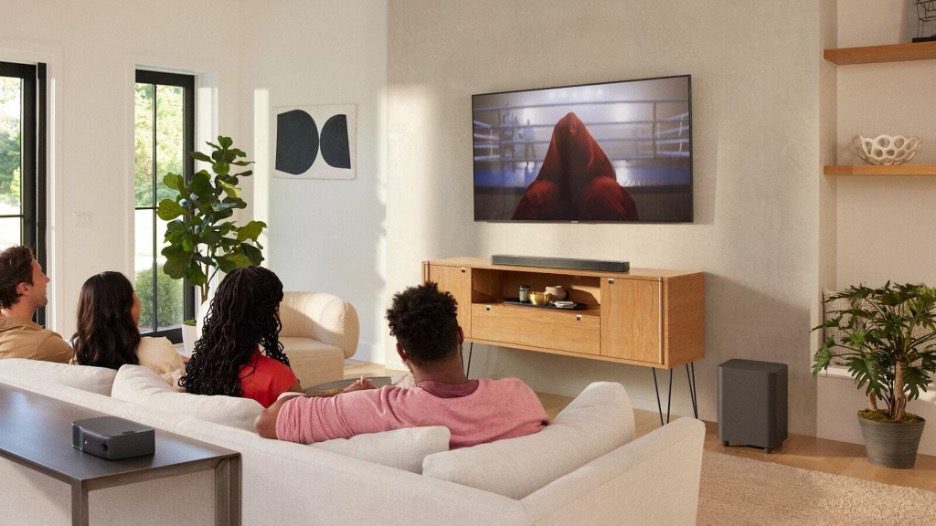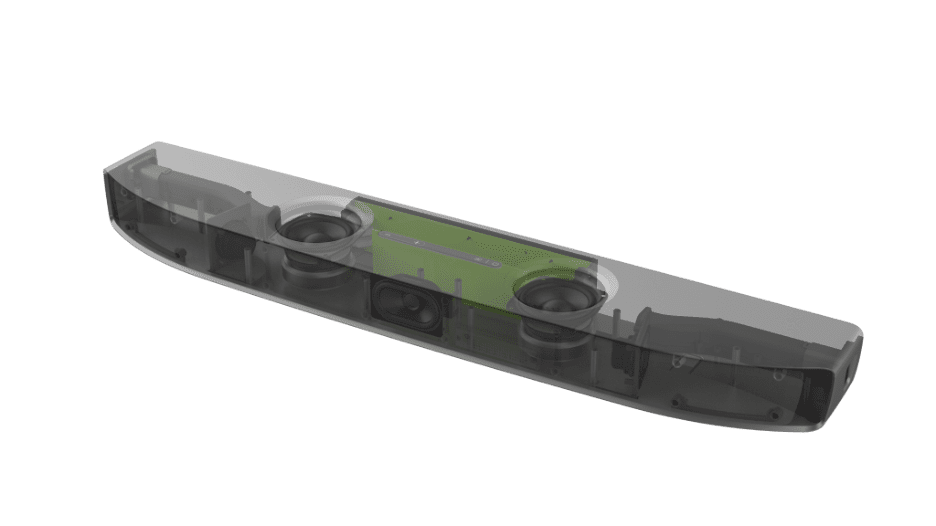If you are part of the enthusiastic audiophile community, you already understand the importance of having a properly engineered sound system to enjoy your favorite music or audio material.
When it comes to enjoying TV shows and movies, more often than not, the sound quality you will achieve in your living room doesn’t compare to the immersive sound experience the material was designed for. The reason is simple. The sound system on your TV can be limited, especially compared to the audio experience you can enjoy in a cinema environment.
As a result, many audiophiles are looking for alternative setups to enhance the sound quality. You have heard of speakers used to amplify the sound. But to achieve optimal rendering, you are likely to need multiple speakers and wires. While this setup is effective and suitable for large spaces, such as a theater, it doesn’t always work inside your living room. As such, you want to look for a space-saving alternative that is capable of matching the level of traditional surround sound systems without the hassle of multiple speakers. Here comes the soundbar to revolutionize your TV experience.
Whether you are already using a soundbar or considering how to build the best setup, you will be faced with an important question. Is a soundbar alone enough, or should I use a soundbar and subwoofer setup instead? At Jazz Hipster, our sound experts answer your questions and help you create the most satisfying audio experience for your lifestyle.

What is a soundbar?
The first and most commonly asked question about soundbars is: How do they differ from speaker systems? To put it simply, a soundbar is a speaker system that is easy to install. When placed underneath the TV, its main purpose is to replace the television’s built-in speaker system, which is precisely what an external speaker does. So, in this instance, a soundbar provides exactly the same function as an external speaker.
Does it mean that soundbars and surround speakers are interchangeable? No, they serve the same purpose but they do not necessarily deliver the same sound experience.
Do I need a soundbar with my TV?
Most TVs are built for image quality. As a result, there can be a significant discrepancy between the quality of the image on screen and the quality of the sound produced by the TV. The typical flat design makes it hard to integrate high quality sound systems. Consequently, the only option for an immersive home cinema experience is to add external speakers to the TV.
Up until soundbars came to the market, sound enthusiasts had to resort to wiring external speakers for a full surround experience. The process is non-only time-consuming, but can also be visually unappealing if you can’t contain the wiring out of sight. More to the point, the addition of multiple speakers inside your living room can also present real physical challenges as you could be running out of space.
A soundbar combines 7 speakers in a relatively small and narrow device that fits underneath the TV, making it easier to connect to the TV.
Why use a soundbar instead of surround speakers?
First of all, in an ideal world, every home entertainment setup would have its own set of surround speakers for an immersive experience. But in reality, audiophiles are the first to identify the problems of such a setup.
A surround speaker system can come at a high cost, making it a less affordable option for homeowners. Additionally, wiring individual speakers to the TV can be challenging, demanding time, effort, and professional skills. Finally, to create an immersive surround effect, speakers must be placed around the home entertainment area. This means that in a smaller environment, viewers must compromise on the number and location of their surround speakers.
Comparatively, a quality soundbar can provide a high-quality surround sound experience without the hassle of:
- Multiple wiring requirements
- Limited space availability
- Financing a multi-speaker setup
Key features of soundbar technology
In a surround speaker setup, speakers are placed in different positions across the room to surround the viewers. The soundbar replicates surround sound effects by using single amplified speaker technology.
The soundbar consists of 3 parts.
Speaker box
This first part produces the sounds. It comprises woofers for low frequencies and tweeters for high frequencies.
Sound processing unit
This part processes the signals before sending them to the amplifiers. At this level, the digital signal is converted into an analog format for the speakers. This is where you can adjust the sound base quality by manipulating bass, treble and other settings.
Each speaker inside the soundbar is fitted and positioned to create a psycho-acoustic effect, aka an audio illusion that makes you believe the sound is around and behind you. Soundbars send different sound beams that are designed to bounce off the wall, which is how they generate the surround effect.
Similarly, if your soundbar has a wireless option, you can stream your favorite music in the same way, by generating a hyper immersive experience.
Amplifiers
Typically, a soundbar counts 2 amplifiers, which are designed to power up additional components, including woofers and tweeters for the built-in speakers. The bass and treble output are mixed together in a soundbar to enable high quality listening experience for music and films.

What is a subwoofer?
Your speakers naturally convey low and high frequencies. The in-built woofer is designed for low frequencies, such as bass guitar, or explosion sounds. A subwoofer can elevate your listening experience by enhancing the delivery quality for lower frequencies. In short, it’s all about the bass sounds.
In other words, while you can already hear low frequencies through a conventional speaker, the subwoofer is built specifically to convey those frequencies, typically between 20 and 90 Hz, delivering deeper sounds in all clarity. Most speakers can lack clarity beyond 90 Hz.
Why do I need a subwoofer?
There is no denying that you will hear the bass sound without a subwoofer. But a quality subwoofer will considerably improve your overall surround system, making the overall experience more immersive.
By adding a subwoofer, you can receive more accurate sound, which helps take away the lifting effect produced by the soundbar speakers.
Key features of subwoofer technology
First of all, a note on low frequency sounds. Frequencies below 100 Hz, which are the frequencies for which you require a subwoofer, are omnidirectional: They travel in all directions from the source, and do not require bouncing off walls to create a surround effect. As a result, you only need to buy as many subwoofers as you have surround speakers. However, the acoustic quality of your structure can affect the full quality of the listening experience and may require more than one subwoofer.
A subwoofer consists of 3 main components
- Driver (or woofer): The subwoofer uses large drivers (also called woofers) to produce much deeper sounds.
- Cabinet: The subwoofer is typically enclosed in a structure made of plastic or wood.
- Amplifiers, which help power up the signal for a bass sound.
A quality subwoofer needs to deal with sound transitions from speaker to speaker effectively. This will determine the frequency at which your subwoofer takes over the speakers. You can set up the crossover to approximately 10 Hz above the speaker’s lowest frequency range.
Why use a soundbar and subwoofer together?
Whether you use your soundbar to enjoy music or to watch bass-heavy movies, such as action movies, you will achieve a cleaner bass sound by adding a subwoofer to the soundbar.
As explained above, traditional built-in woofers can lose clarity and quality of sound for sounds starting from 90 Hz and below. The addition of a subwoofer can help maintain bass quality for low-frequency sounds. This will result in less distortion for loud and bass sounds.
The combination of a subwoofer with a soundbar can expand your range of sounds, adding sounds that the soundbar speakers are not able to reproduce.
Additionally, as a subwoofer will deliver omnidirectional sound beams, it also enhances the immersiveness of your experience with the soundbar.
How to choose the right soundbar and subwoofer for your needs
If you are in the process of shopping for a subwoofer, there are essential considerations to bear in mind to maintain high sound quality.
Soundbar connection
Bear in mind that not all soundbars are built the same. Ideally, you want to ensure that both the soundbar and the subwoofer are compatible designs, preferably from the same manufacturer or from explicitly compatible manufacturers.
Subwoofer accessories
Reducing visible wiring is a priority with a soundbar and subwoofer setup. Therefore, you may want to prioritize wireless subwoofer designs.
Cabinet size
A small and minimally invasive subwoofer will not affect the design of your interior. Therefore, it may be a good idea to look for compact models that can be seamlessly integrated into your decor in a sealed cabinet.
Listening choices
Bear in mind that while soundbars are able to deliver an immersive surround experience, they are not equipped to match the same immersion of a 5.1 home theater surround setup. So, it is important to approach the addition of a subwoofer with realistic expectations.
How to connect a subwoofer to a soundbar
There are two main ways to connect a subwoofer to a soundbar.
You can use a wiring system if the soundbar enables you to connect a device physically.
Alternatively, more and more setups allow for wireless pairing. Most devices can pair automatically when they are compatible, and both turned on without disruption in the same space. If you have any issues connecting your devices, please do not hesitate to get in touch with our team of experts, who are happy to advise.
Best Acoustic Technology Partner
For 40 years, Jazz Hipster has specialized in researching, developing and manufacturing of acoustics. In addition, we have been involved in developing digital sound optimization for years, including related technical fields of wireless speakers. It provides complete, from the designing of speaker drivers, sound quality adjustment to developing customized software and platform. The one-stop acoustical solution spares no effort in pursuing the ultimate surround experience.
We understand the need to enjoy high sound quality in a minimalist situation, which is ideal for all consumers and brands.
Latestly, Jazz Hipster designed a variety of audio equipment for seamless surround and immersive music and video enjoyment.
We actively cooperate with Dolby to provide both Suitable for TV and music, gaming and sports, for delivering the best immersive surround quality.
Whether it is Soundbar, Wi-Fi wireless speakers, or woofers, the ultimate goal is to obtain a complete home theater experience and support the Dolby ATMOS standard.
Are you interested in our services and technical capabilities? Please feel free to contact our team!




